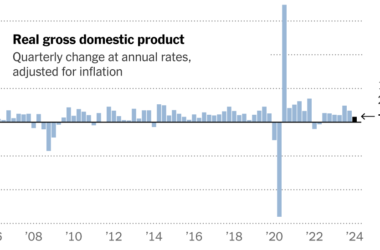There’s a three-letter abbreviation that economists have began announcing with the vitality of a four-letter phrase: “O.E.R.”
It stands for proprietor’s equal hire, and it has been used to measure American housing inflation because the Nineteen Eighties. As its title suggests, it makes use of a mix of surveys and market information to estimate how a lot it might value owners to hire the home they stay in.
However three years into America’s worth pop, it has develop into nearly cliché for economists to hate on the housing measure. Detractors blast if for being so slow-moving that it doesn’t mirror up-to-date situations within the financial system. Critics argue that it makes use of convoluted statistical strategies that make little sense. Probably the most intense haters insist that it’s giving a misunderstanding about where inflation stands.
“It’s simply not including something to our understanding of inflation,” stated Mark Zandi, chief economist of Moody’s Analytics and a frequent adviser to the Biden administration. Full disclosure: The New York Instances referred to as Mr. Zandi for this text as a result of he has been one of many many economists grousing about O.E.R. on social media. He stated he was “not a fan.”
What has this one nerdy inflation element performed to earn a lot vitriol?
It’s stopping an financial completely satisfied ending, kind of. Housing inflation measures have been surprisingly sticky over the previous 12 months, and they’re now a significant barrier holding worth will increase general from returning to regular. That has knock-on results: Due to inflation’s endurance, the Federal Reserve is holding rates of interest at a greater than two-decade excessive to attempt to wrestle costs below management by slowing the financial system.
However whereas there’s no denying that O.E.R. has develop into a important character in America’s inflationary story, not everybody thinks it’s the unhealthy man. Some economists assume it’s a legitimate and affordable solution to measure an vital a part of the buyer expertise. Forward of a recent Shopper Worth Index report set for launch on Wednesday morning, there are a number of key information to know about how housing inflation is calculated, what it means and what it’d do subsequent.
O.E.R. tries to measure housing ‘consumption worth.’
Let’s begin with the fundamentals. There are two important measures of inflation in America, the Shopper Worth Index and the Private Consumption Expenditures index. Each matter: C.P.I. is launched earlier every month, offering the primary snapshot of what costs have performed over the previous month. P.C.E. comes later, however it’s the index that the Fed officers intention for with their 2 p.c inflation objective.
The 2 indexes monitor barely totally different ideas. The Shopper Worth Index tries to seize what individuals are shopping for out of pocket (i.e., what you’re spending), whereas the Private Consumption Expenditures measure captures the price of issues like medical care that employer-provided insurance coverage helps to pay for (i.e., what you’re consuming).
Each draw on the identical underlying housing information, however due to their totally different calculations, housing makes up a a lot greater chunk of the Shopper Worth Index: about 33 p.c, versus about 15 percent for the P.C.E.
The C.P.I.’s hefty housing portion comes from two sources. “Hire of major residence” measures how a lot individuals are spending on rental housing and accounts for about 8 p.c of the full inflation index. The “proprietor’s equal hire” metric, the one which estimates the rental value of owned housing, makes up a a lot bigger 25 p.c.
You could be considering: Why is the federal government utilizing this convoluted housing measure when it might be easier to only measure house worth appreciation? The reply is that homes are an funding. Counting their worth will increase as “inflation” could be akin to saying a climbing inventory market is “inflation.”
However houses aren’t simply an funding. Housing can also be one thing we devour, and by residing in a home, an proprietor is forgoing the monetary alternative of leasing it out. So to get on the “consumption worth” of proudly owning that home, the federal government tries to determine how a lot it might value to hire it.
How we estimate that hire is slightly wonky.
The federal government makes use of what is actually a two-step course of for figuring out housing value inflation. Step 1: Determine how a lot weight hire and proprietor’s equal hire ought to get within the inflation index versus every thing else customers purchase. Step 2: Determine how a lot rents are literally growing.
Step 1, the burden, is based on two survey questions: In case you personal, how a lot might you get when you rented out your home or house? And when you hire, how a lot do you pay?
Step 2, the change in worth, relies on precise rental information. The federal government collects information from a rolling pattern of rental housing models, checking in on every unit each six months to see if the owner is charging extra. (It makes changes to those figures: As an example, single-family homes carry extra weight within the proprietor’s equal measure, since owned housing is extra prone to be a house versus an house.)
Mix the burden with the worth change and, bam, you may have your housing contribution to inflation. With housing, Shopper Worth Index inflation totaled 3.4 p.c in April. Subtract housing and re-weight the index accordingly, and inflation would have been one thing like 2.3 p.c.
Clearly, housing inflation is a significant motive inflation stays elevated.
We’re nonetheless ready … and ready … for extra cooling.
Economists have been ready for housing-fueled inflation to fade extra sharply. Market information produced by firms like Zillow and data on new leases produced by the federal government each present that hire will increase on newly leased locations have cooled quite a bit over the previous two years.
However inflation indexes measure all housing, not simply the newly rented locations. When market hire costs jumped in 2021, not all tenants instantly noticed their rents reset to greater ranges: Landlords have steadily reset leases to greater costs, inflicting that earlier pop to slowly present up in official housing inflation information.
Forecasters thought the catch-up course of would peter out in 2023 and 2024, permitting housing prices and general inflation to come back down notably. However the convergence between new and current hire inflation is taking quite a bit longer than anticipated.
Economists nonetheless count on the pass-through to occur, however they’ve gotten much less assured about how rapidly it’ll come and the way intensive it’ll show. And some are watching nervously as some measures of latest house rents present indicators of ticking again up. A hire measure tracked by the analysis agency Zelman & Associates can also be displaying early indicators of renewed power.
“In case you had requested me six months in the past, I might’ve stated: Sure, they’re going to should converge,” stated Mark Franceski, a managing director at Zelman. “Every month that has passed by and so they haven’t, I’ve gotten much less assured.”
So does O.E.R. have a spot in inflation?
As a result of as we speak’s housing inflation is actually catch-up inflation, some economists assume we must always look previous it. In Europe, some level out, the principle inflation measure excludes owner-occupied housing altogether.
However whereas the measure will get a whole lot of warmth for being “fake” or “inflationista,” or primarily based on the frequent (however incorrect) assertion that it comes from a doubtful survey, some economists stand by it.
“Let me break with the children and defend O.E.R.,” stated Ernie Tedeschi, who till not too long ago was the chief economist on the White Home Council of Financial Advisers. For one factor, it’s vital to face by the inflation metric you began with, he stated. Transferring the objective posts might undermine the general public’s belief within the Fed’s dedication to preventing inflation.
Mr. Tedeschi additionally pressured that the O.E.R. tries to get at an vital thought. As the worth of housing modifications over time, it shapes our financial lives.
If a home-owner have been to maneuver and wanted to hire, doing so could be dearer, for example. (Europe, for what it’s value, is working on creating its personal owner-occupied housing prices measure expressly as a result of it is a crucial element of inflation.)
Simply as hard-to-measure forces in physics are essential to the way in which the universe works, Mr. Tedeschi stated, the worth we derive from the place we stay issues enormously to the functioning of the financial system — even when it’s sophisticated.
“O.E.R. is kind of the darkish matter of economics,” he stated.









